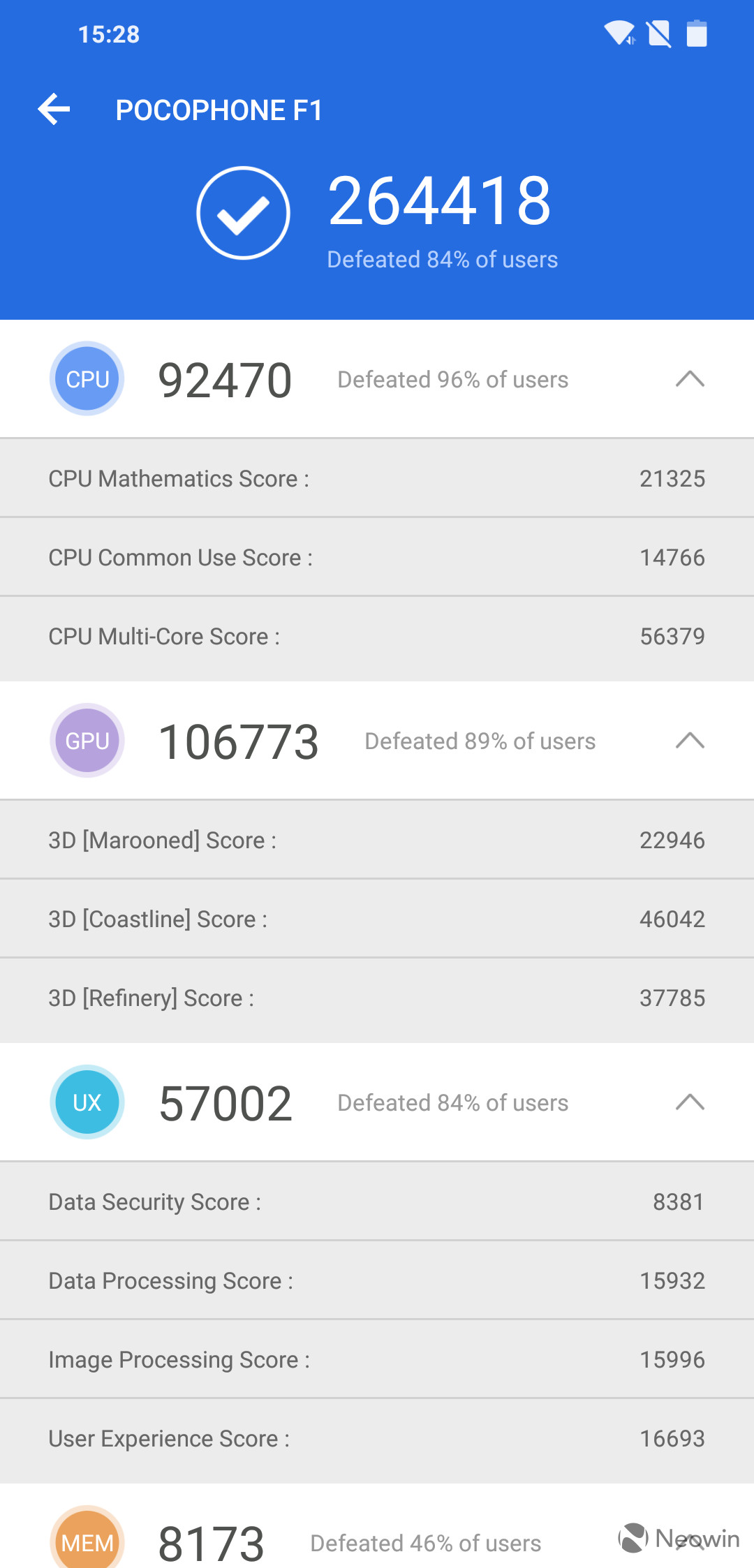Dubbed the 'master of speed', the Pocophone F1 was an almost seismic shift in the smartphone landscape when it first dropped earlier this year. Pairing a Snapdragon 845 processor that could only be found in flagship phones with a phone that was sold for less than many other midrange options, Xiaomi's sub-brand Pocophone was bound to have a hit on its hands. Read on to find out if the Pocophone F1 is too good to be true, or if Xiaomi really has pulled off a miracle.
Specifications
|
CPU |
Qualcomm Snapdragon 845 |
|
GPU |
Adreno 630 |
|
Operating System |
MIUI for POCO 9.6 (based on Android 8.1 Oreo) |
|
Display |
6.18" FHD+ 2246 x 1080p (18.7:9), 403 ppi, IPS LCD |
|
Connectivity |
Audio: 3.5mm socket Bluetooth: 5.0 Cellular: Dual SIM | 2G/3G/4G Location: GPS, A-GPS, GLONASS, BDS Wi-Fi: 802.11 a/b/g/n/ac, dual-band, Wi-Fi Direct |
|
Security |
Rear fingerprint sensor |
|
Body |
155.5 x 75.3 x 8.8mm |
|
Camera |
Rear: 12MP + 5MP, LED flash |
|
Video |
2160p@30fps |
|
Camera Features |
HDR, AI scene detection, AI Beautify, Portrait Mode, multi-frame noise reduction |
|
Storage |
64/128/256GB + 256GB microSD expansion |
|
RAM |
6/8GB |
|
Battery |
4,000 mAh |
|
Colours |
Graphite Black, Steel Blue, Rosso Red, Armoured Edition (special edition) |
Design and display
The guts of the Pocophone may match any flagship you could throw at it, but its external design is quite another matter altogether. Even compared to the cheaper $220 Nokia 6.1 Plus I was using prior, the approximately $300 Pocophone feels far less premium and smooth. That's largely because Pocophone had one singular goal in mind when crafting this device, which it has executed to near perfection: create the fastest phone possible, for the cheapest price possible.
You're not going to find a smooth-feeling glass back on the phone, or, indeed, most of the design bells and whistles other phones may have. That's not entirely a bad thing, as the polycarbonate back is plenty sturdy and comfortable enough to hold in hand. The graphite black model I was provided looks...okay, but it's certainly not going to win any awards for its good looks.
There's a Pocophone logo embossed in silver on the back with a tiny 'by Xiaomi' underneath it to show the phone's ultimate provenance. The rest of the back is plain, except for the barely visible certification symbols at the bottom and the dual camera setup with a flash up top. The two sensors are arranged in a vertical array, and right underneath the two is the fingerprint sensor.
That sensor is insanely fast, and is among the fastest I've come across, being more or less instantaneous in my experience. Unfortunately, it's a little diminutive and placed inside a ridge below the camera array, so you'll need a little time before you get used to its placement.
The phone also features infrared face unlock functionality. That's not as accurate as the 3D facial recognition tech you'd find on the iPhone X or the Huawei Mate 20 Pro, but it definitely is quite convenient to have the phone recognise my face even in pitch darkness. Just like the fingerprint sensor, unlocking the phone using your face is also pretty fast, though it wasn't entirely reliable, and was sometimes unable to recognise me.
Up front, you have the 6.18-inch LCD panel with a resolution of 2246x1080. The screen is bright and crisp, with vibrant colours. It's not AMOLED, which means you won't get those battery-loving deep blacks, but it should be good enough for most people. It can also get ungodly bright, which translates into the screen being clearly visible even under direct sunlight.
At nearly 6.2 inches it is definitely quite large, and a little hard to handle single-handedly. I found it to be an adjustment moving from the one-handed comfort of the Nokia 6.1 Plus to the Pocophone F1, but the larger screen is a boon when it comes to watching videos and playing games. The screen also has a notch, though Pocophone did at least manage to fit in a second speaker and an IR sensor in there. Joining the two is the front camera in the same spot, so there may be something to be said for the benefits of having a notch.
The rim of the phone consists of an aluminium framey, with the two volume buttons and the power button on the right. I would have preferred it if we had a rocker instead of two separate buttons for volume, but the existing setup isn't bad by any means. You also have a headphone jack up top, and a speaker grille at the bottom.
Battery life
When it comes to battery life, only one word comes to mind: amazing. A 4,000mAh battery paired with a Snapdragon 845 is basically the same setup as the Galaxy Note9, which was considered the king of battery life until the release of the Mate 20 Pro. And just like the Samsung phablet, the Pocophone F1 has some of the most impressive battery life on any phone you can find today, and should easily be able to provide you with up to two days of use.
The phone also supports 18W (9V/2A) charging thanks to Qualcomm's Quick Charge 3.0, resulting in very quick charge times. It takes around two hours to fully charge the 4,000mAh battery inside, but you can easily get to a comfortable 70% charge in around an hour. Charging speeds tend to slow down a bit after that. Another bit of good news is the presence of a USB-C port on the phone.
Camera
The camera setup on the Pocophone F1 consists of 16MP+5MP dual sensors on the back and a 20MP selfie shooter on the front. The quality of the output here isn't breathtaking per se, but it certainly is impressive. Let's also not forget that while you may think you're reading the review of a flagship device, the phone is, at the end of the day, priced at $300. Corners need to be cut to maintain that price, and camera quality is certainly one area where the handset simply can't compete with the big dogs in the Android world.
That's not to say the cameras on the phone are bad by any standards; for their price, they are quite good. In daylight conditions, images look good and crisp. That said, you may find some images to be a little too saturated (take a look at the pink flowers in the attached image gallery), which I do wish Xiaomi would tone down just a little bit.
Given the dual camera setup, the phone can also take portrait mode photos for that oh-so-enticing bokeh effect in pictures. Even with just one camera on the front, I found the edge detection in portrait photos to be rather good. Xiaomi's software game is certainly on task, as portrait mode selfies too are quite accurate in applying the blur effect.
One pet peeve I found here was that selfies are automatically enhanced with what other manufacturers call 'face beauty', which smooths out your skin. There's also no option to turn it off in the settings, which is rather annoying. Adding to that, rear camera pictures are all watermarked with 'Shot with Pocophone F1' out of the box and you need to manually turn it off in the settings, something I did not appreciate. To top it all off, there's seemingly no way of removing the watermark on images that have already been saved. Self-promotion is well and good, but I feel like it's taken a little too far here.
Performance and storage
We can't have a review of the Pocophone F1 without a discussion on the self-proclaimed master of speed's performance chops. Over the years, this section of the review has become less meaningful as smartphones have become more powerful and, thus, capable of serving most people's needs even at the lower end of the market.
In the case of the Pocophone, its biggest selling point is that it provides exactly the kind of performance you'd expect from a $1,000 flagship for the cost of one of those lower-end devices. There's also some liquid cooling technology to ensure heat dissipation is a cut above most other phones. What all of this results in is a phone that packs a punch that is way above its class and is simply fast and fluid, regardless of what you throw at it.
All this is reflected in the benchmark scores, starting with Geekbench:
GFXBench, which tests graphical prowess, presents equally impressive results:
Rounding out the suite is AnTuTu:

The phone's combined 6GB of RAM and a minimum of 64GB of internal storage should be more than enough for you to zip along between multiple apps, and also provide more than enough storage for most. If you need more space, you can always expand it by up to 256GB via the microSD slot.
Software
While the hardware on the Pocophone F1 is simply among the best you can buy in the Android world currently, when it comes to software, it's a bit more hit-or-miss. If you've used a Xiaomi phone before and are accustomed to its MIUI, you'll be fine. But if you're a new user, it's definitely a learning curve and your overall disposition toward the skin will vary. If you're an avid proponent of stock Android, you may not be all that pleased.
Still, the software is still a little more palatable for newcomers than what you'd find on most Xiaomi phones. That's because while it's running off of MIUI 9.6, the included launcher is specially designed for the Pocophone and includes things like an app drawer, masking some of the Xiaomi-ness of the software experience with a more familiar UI.
Some notable pain points for me were the lack of selectively turning off only certain types of notifications for an app, something newer versions of Android allow. In MIUI, it's a bit more of an all-or-nothing story when it comes to managing app notifications. You'll also find that the phone suffers from a bit of a split personality disorder, with Google and Xiaomi's respective ecosystems vying for your attention and loyalty; there are two apps for almost every basic phone function like the browser or the gallery.
While I tried to stick with Xiaomi's offerings for the purposes of this review, it became simply impossible to do so when, for example, I needed to access the photos synced to my Google account. You may not be able to delete Xiaomi's apps, but if you are already invested in Google's ecosystem, it's also not particularly difficult to just keep on doing what you're doing. You'll just have to go through a ton of clicks and confirmations to change your defaults; boy, Xiaomi really doesn't want you to change those.
There's also some excellent news on the Android 9.0 Pie side of things as the company has already started flighting MIUI 10 (based on Android 9.0) in beta form to Pocophone F1 owners, so an official release will hopefully come soon. Some of Pie's features, like gesture-based navigation, are already found in MIUI 9.6.
I liked the implementation Xiaomi has gone with - which is a lot more like what you'd find on an iPhone - in comparison to Google's setup, but one gripe I had was with the 'back' gesture. That's triggered by swiping in from either edge of the screen. Since Android apps more often than not hide a hamburger menu and require you to pull it out from the left side of the screen, you'll find yourself going back instead of pulling out the menu more often than not. The same is true when you're trying to swipe away notifications and instead end up closing the notification pane. To avoid that, Xiaomi reserves the lower half of the screen for the back gesture and the top half for the app but on a screen as large as this, it's rather hard to successfully pull it off every time. As bezel-less displays become more common in the Android space, I really hope that either the app ecosystem will evolve vis a vis hamburger menus or that Xiaomi and others will be able to find a better implementation for gestures.
Though none of these are actual deal breakers, one big problem plaguing the Pocophone F1 is the lack of Widevine L1 support, which means you can't watch HD content on apps like Netflix. Pocophone has promised a fix is incoming soon, but as our Jeet Suthar points out, adding Widevine L1 support normally requires sending the phone back to the manufacturer so I'll wait and see exactly how the company is planning to live up to its promise. For now, I'll be marking the lack of HD streaming support as a major con that potential owners of the phone need to be aware of.
Another big problem I faced was that some apps would simply not take advantage of the full screen and would be cut off halfway through. Pocophone has promised a fix for this as well, but for now, it's a waiting game.
Conclusion
Reviewing the Pocophone F1 is a...confusing job. It's an almost Frankenstein's monster-like contraption, forcing together best-in-class performance with the frugality of the cheapest of budget smartphones. There aren't really too many other devices for me to compare it to, making it a rather unique curiosity in the vein of the OnePlus One when it was first revealed.
Like that phone, its starting price is around $300 and it truly is shaking up the smartphone scene and makes you question just how much you should spend on your next phone. There's no doubt that Pocophone has made some sacrifices to bring the F1 to market at such a low cost, mainly in terms of its design and camera quality. However, in almost all cases, you really won't notice the cut corners too much. In other areas, like the inclusion of an IR scanner, the phone even offers features that almost no other phone has.
If you don't want the prettiest phone on the block and can put up with the learning curve associated with MIUI, the Pocophone F1 is simply the best handset on the market right now in terms of pure value and easily earns my recommendation for users who want the most phone for the least amount of money. The only question that remains is if sequels will retain the $300 pricing or if they'll go the OnePlus route and slightly increase the price with each generation. Either way, Pocophone's very first phone comes in with quite a bang and is possibly the marquee device of the year, not because better options don't exist, but because none of them shakes up the market quite like the F1 does.
One tricky thing about the F1 is availability. Buyers in many Asian markets should be able to snap up the Indian-made handset with no problems, and its also available in Europe. You even get 4G support on UK networks, but US customers are unfortunately not as lucky. B&H Photo Video started taking preorders for the phone in the US earlier this month, but the phone does not support 4G networks in the United States, so you may have to suffer through 3G speeds if you decide to buy the 'master of speed' in that country.



































11 Comments - Add comment